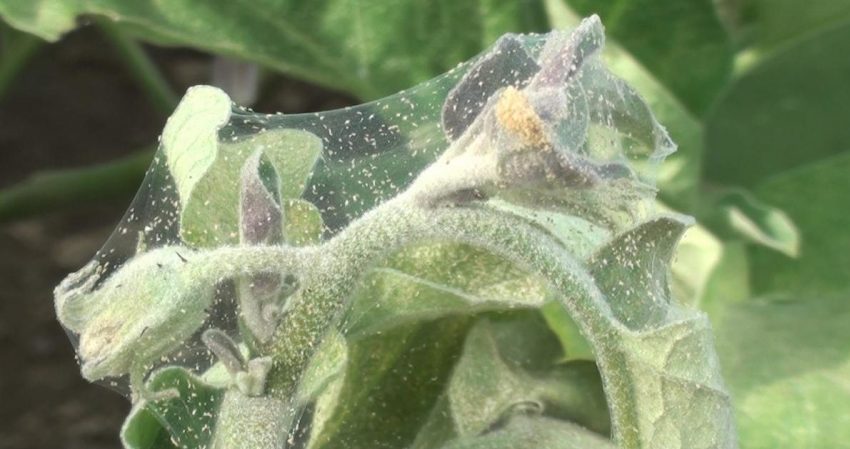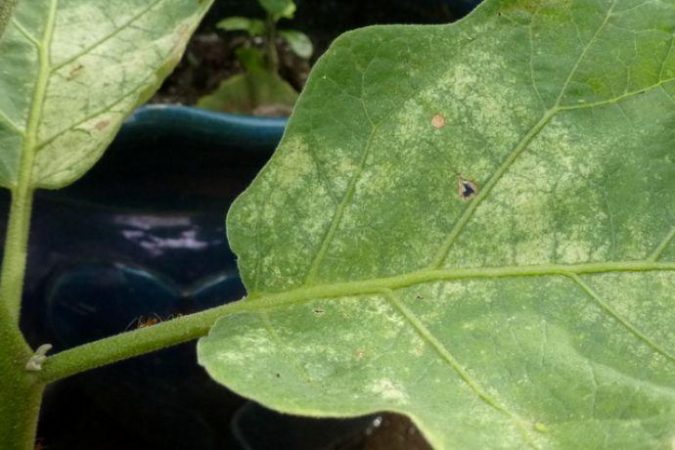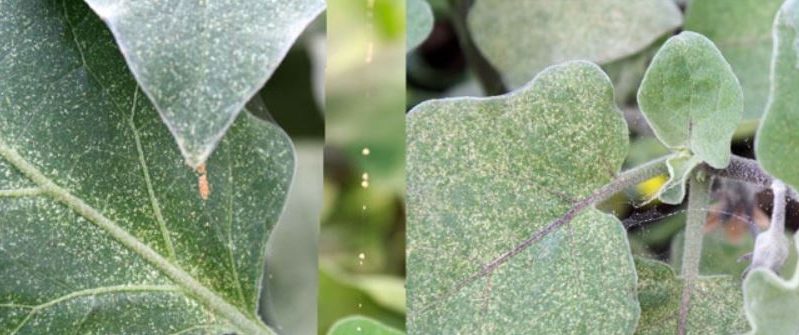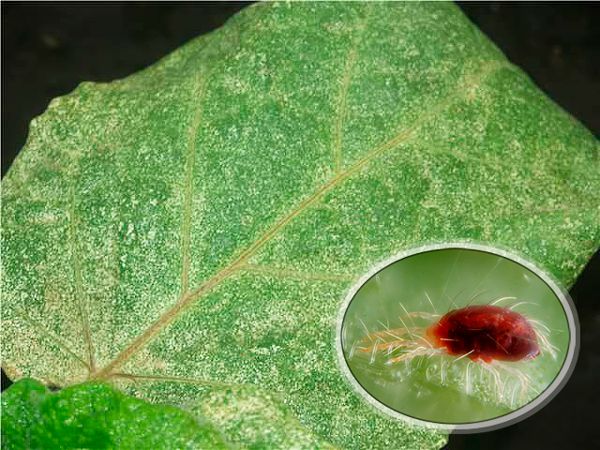What is the danger of a spider mite on eggplant and how to effectively deal with it
The appearance of pests in the beds always requires immediate action. First, you need to recognize the threat in order to choose the correct method of plant treatment. Further in the article, we will consider what spider mites are and how dangerous they are, and we will analyze various methods of dealing with these insects.
The content of the article
Signs of spider mite damage to eggplants
The first visible signs of damage appear when the tick has already thoroughly settled in the plant and harmed it. After all, the insect itself is so small that it is simply impossible to notice it.
The main signs of defeat:
- Cobweb under the bush.
- Gradual drying of the tops eggplant.
- Small white dots on the leaves, which grow over time into spots of marble color.
- The growth of the bush slows down significantly.
- The plant takes on a sickly, wilted look.
The photo shows the affected plant.
Harm done
The spider mite reaches its mature stage very quickly - in just one week. Insects settle on the underside of the leaves, bite through their pulp and suck out the juice. Because of this, the plant quickly loses moisture and nutrients.
Important! After a few weeks, the eggplant can die completely if the necessary measures are not taken.
With the onset of cold weather, fertilized females form dense orange lumps covered with cobwebs, and so they hibernate. In the spring they lay eggs, and after 2-4 weeks a new generation of mites appears.
Control methods
Due to the short life cycle of the spider mite, each subsequent brood develops more and more immunity to various drugs. Therefore, it is necessary to take measures to combat the pest immediately and as soon as possible.
Chemical insectoacaricides
Using chemicals is the fastest and most effective way to control pests.
Important! You should carefully read the instructions on the packaging of any chemical product so as not to harm the landings. It is also necessary to use gloves and closed clothing so that the drug does not get on the skin.
Let's take a closer look at some of these tools.
Colloidal sulfur
To prepare a solution, 40 g of the substance is diluted in 5 liters of water. Water is added gradually to dissolve the sulfur evenly.
Ticks die within three days of spraying.
Processing is not carried out during the flowering period and is stopped a few days before harvesting.
"Bitoxibacillin"
Sold in powder form. Dilute 100 g of dry matter in a bucket of water. The solution is sprayed with eggplants during or before flowering. Stop spraying a week before harvest.
After treatment, the insects die within 3-5 days. A week later, re-treatment is carried out.
Fitoverm
The active substance - aversectin - paralyzes insects. The action does not apply to the eggs of ticks, therefore, repeated treatments are necessary.
Paralyzed insects die within 3-6 days, depending on their vitality.
The substance remains on eggplants for 20 days after processing. In case of high humidity or rain, this period is reduced to a week.

"Actellik"
This is a fast-acting remedy: ticks die within a few minutes. It has an enteric effect on pests.
Spraying is carried out in dry weather at an air temperature of 12 to 25 degrees.
To prepare a solution, 1 ml of the substance is diluted in 1 liter of water. This is enough to process a plot of 10 sq. m.
Biological measures
The biological measures to combat the spider mite on eggplants include settling its natural enemies on the beds. It can be lacewing, western metaseiulus, amblyseius or phytoseiulus. The latter are preferable, since they reproduce faster and eat not only ticks, but also whiteflies.
Fitoseyulus is sold in bottles of 100 ml. One bottle contains about 2000 insects. They must be used within the first 18 hours after purchase. Depending on the number of acariphage pests (predatory mites), from 10 to 50 individuals are evicted per 1 sq. m. Bottles have special dispensers, so you just need to plant predators on the leaves of the plant.
Important! Before using biological agents, make sure that no chemicals harmful to these insects have been used in the last 2-3 months.
This method is effective for light infestation with spider mites.
Traditional methods
Calendula, chamomile, datura, yarrow, dandelion, onion peel and garlic negatively affect the insect. An infusion of these ingredients is sprayed with eggplant.
Effective recipes:
- Pour 150 g of chopped dandelion leaves and 150 g of horse sorrel roots with a bucket of water and leave for a day. Strain and spray the affected plants.
- Pour ½ a bucket of onion skins with a bucket of warm water. Insist for three days, then strain. Add 2 g of laundry soap for every liter of water. Dilute the infusion with water in a 1: 2 ratio before processing.
- Pour 1 cup of minced garlic with a bucket of water. Insist one day. Strain.
Plants are treated several times every 5-7 days.

How to fight in a greenhouse and open field
In a greenhouse, it is a little easier to overcome spider mites. It is easy to control humidity and air temperature here. Sometimes even simple preventive measures and folk methods are enough. But with chemicals in the greenhouse, you need to be careful. Strongly toxic substances cannot be used categorically. Colloidal sulfur is great for a greenhouse.
In the open ground, it is possible to control climatic conditions only partially: to cover the plantings from rain or strong winds, or to protect them from animals.
At the same time, it is permissible to use any drugs on the street. But it is better to give preference to low-toxic ones, because poisons also affect the plant.
Preventive measures
The best way to control pests is to prevent them from appearing in the garden.
To do this, the following preventive measures should be taken:
- Regular airing of greenhouses (the temperature should not be higher than 26 degrees).
- Regular watering (especially in hot weather).
- Spraying eggplant in a greenhouse with warm water.
- Disinfection of soil after harvest and before planting.
- Regular weed removal.
Read also:
Unusual Tomato Cream and how to care for it.
Getting ready for winter: how to freeze beans while retaining their beneficial properties.
Tips from experienced summer residents
Experienced gardeners recommend keeping your garden clean and tidy and being attentive to your plantings. In a clean and well-groomed garden, plants rarely get sick and have strong immunity.
Here are some tips to help you manage a tick:
- It is better to pluck the damaged parts of the seedlings without regret.
- Do not rush to use strong chemicals. It is better to resort to their help only with a severe defeat.
- It is useful to spray the seedlings with a solution of ammonia (2 tsp per 1 liter of water).
- The web must be removed immediately.
- Strongly increase the humidity (at 90-95% eggs die).

Conclusion
The spider mite is susceptible to the effects of various agents: chemical, biological and folk. The main thing is to start treatment on time and not start the garden.Depending on the degree of development of the tick population, the method of control is also chosen. With a severe defeat, you will have to resort to chemical preparations, and at the initial stage, folk recipes and biological methods will do.